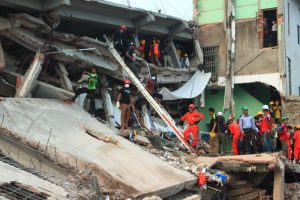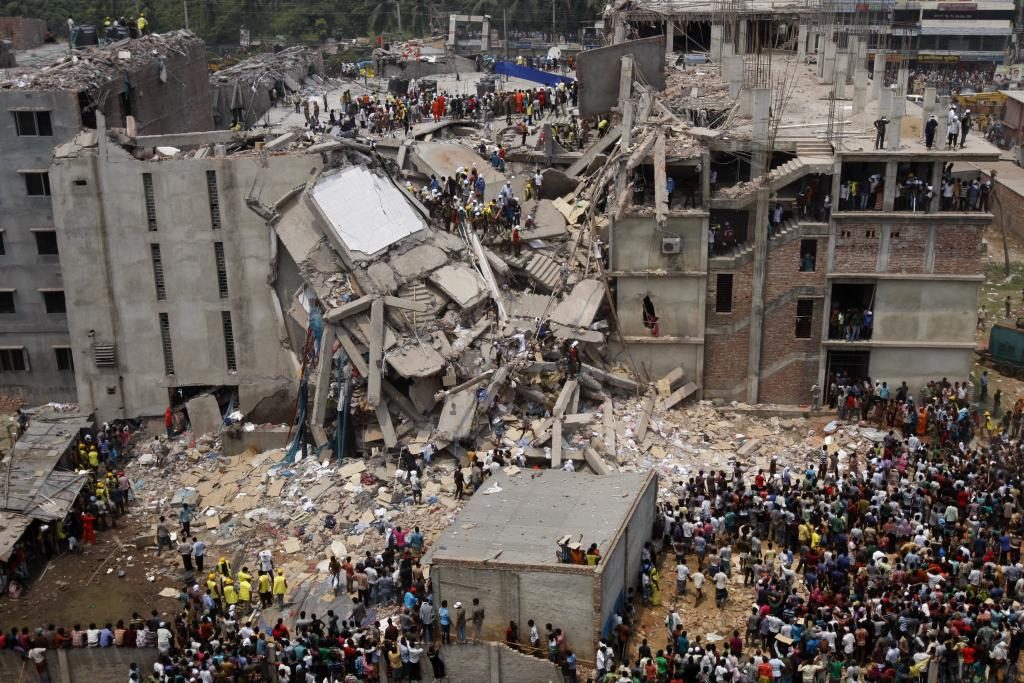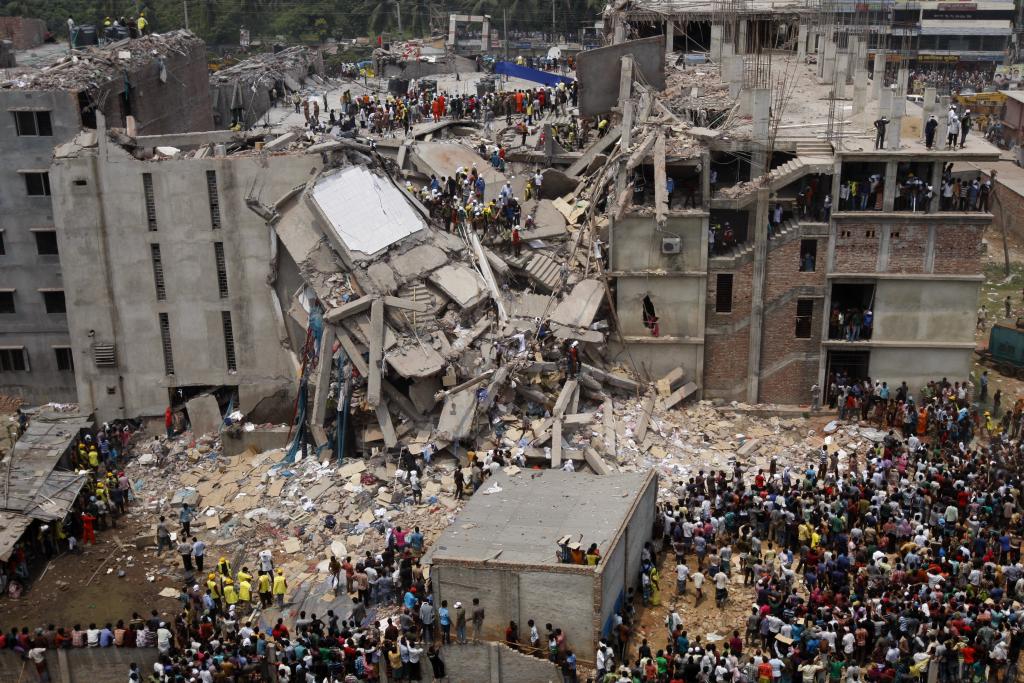It took just less than 90 seconds to graphically reveal the horrific underbelly of globalisation and of ‘modern’ consumerism and business. Five years ago, in April 2013, the eight story Rana Plaza building in Dhaka, Bangladesh collapsed, killing 1,134 people and injuring an additional 2,500. For many locals and for trade unions, the event was seen as a ‘mass industrial homicide’. Rana Plaza contained clothing factories, a bank, apartments and several shops and while the latter (on the lower ground floors) were immediately closed following the discovery of cracks in the building, no such action was taken with respect to the clothing factories.
Local and international reaction to the collapse and the subsequent court case fueled action when about 250 companies accepting two (internationally monitored) agreements the Accord on Fire and Building Safety in Bangladesh and the Alliance for Bangladesh Worker Safety. These agreements were designed to improve safety dramatically in the 2,300 factories plus which supplied western brand names. Judging by local reactions to the impact of the agreements, they have made a difference. The fear of having contracts by western buyers forced thousands of factory owners to invest in fire doors, sprinkler systems, electrical upgrades, stronger foundations etc., tackling over 97,000 highlighted safety hazards in those facilities covered by the Accord alone.
Significantly less factories can now be labelled as ‘death traps’ according to Scott Nova, executive director of the Worker Rights Consortium, an independent labour group. According to a report from New York University’s Stern Centre – Five Years After Rana Plaza: The Way Forward (April 2018), approximately 71 workers died each year in fire and building collapses before April 2013 but in the years since, the number has been reduced to 17 people annually (again, the figures are disputed with many arguing they are significantly higher and substantially unreported).

Progress in work and safety conditions in an estimated 2,000 plus factories (and the additional 3,000 plus sub-contractors – the figure is contested) that do not supply major western brands and are not covered by the agreements remain problematic as they are inspected less rigorously by the Bangladesh government or, routinely not at all. The garment industry remains vital to Bangladesh (the world’s second largest clothing exporter after China – worth some $28 billion in 2016); it has and has contributed significantly to a reduction in absolute poverty for many (and men) and now employs some 5 million of the world’s lowest paid garment workers. However, many thousands more workers still work in sub-contracting workshops (often supplying markets in countries such as Russia and Turkey). How many are employed and under what conditions remains significantly unknown.
However, both agreements are now set to expire but the good news is that international awareness and pressure have ensured that some 176 of the 220 companies in the Accord have signed its extension (including H&M, Zara and Primark) but this figure also means that about 250 factories supplying to western brands would no longer be in the agreement (companies such as IKEA remain outside the agreement preferring, they say, to comply with their own in-house code which continues not to make public its reviews).
Despite this, there are growing concerns as both agreements remain behind defined schedules, due mostly to outright opposition from many factory owners. One Accord update recently reported that ‘major, life-threatening concerns remain outstanding in too many factories and need to be fixed urgently’. According to Laura Gutierrez of the Worker Rights Consortium ‘in terms of the actual progress made in these factories, it’s a black hole’. Demands and action from workers seeking better wages and conditions continue to be met with harassment and violence. Bangladesh has repeatedly attracted harsh criticism from the International Labour Organisation for failing to protect trade unions.
International brands including Zara and H&M have boycotted garment industry meetings in protest at the treatment of workers and the crackdown on unions. As competition increases from garment sectors in Vietnam and Ethiopia, these threats by western buyers are significant but Bangladeshi factory owners complain that such brands want it both ways – insisting on safety improvements while simultaneously demanding lower prices. The amount western brands pay for men’s cotton pants, for example, has fallen by an average 13% since Rana Plaza, according to a March 2018 research report from Penn State University.
Ensuring that the (real but limited) progress to date under the two agreements is sustained remains a challenge not just for Bangladeshis but also for consumers of branded products manufactured there. The Bangladesh Garment Manufacturers and Exporters Association insists it is now time to end the agreements and international monitoring in particular; the obvious danger is that if supervision becomes weak, it could be a case of ‘business as usual’ with significant consequences.

Reports from the Washington based network Global Labor Justice continue to highlight abuse of workers. More than 540 workers at factories that supply the two retailers GAP and H&M have described incidents of threats and abuse in supply chains in Bangladesh, Cambodia, India, Indonesia and Sri Lanka, are the direct result of pressure for quick turnarounds and low overheads.
Those 90 seconds in April 2013 revealed the ugliest dimensions of a globalised garment and fashion industry – something we have all become aware of, even if we refuse to act on it at the point of sale. I recently asked a manager in Dunnes Stores in Cornelscourt, Dublin, about monitoring in Bangladesh and immediately he was in tune with the issue and responded well to my questions even if the outcome remained vague. Continuing to ask these crucial questions and insisting on minimum standards in the supply chain is the least we can do. The 90 seconds also highlighted the importance and impact of such ongoing questioning and international consumer pressure.
Featured photo: Dhaka Savar Building Collapse (May 13, 2013) by Rijans via Flickr (CC license BY-SA-2.0)

